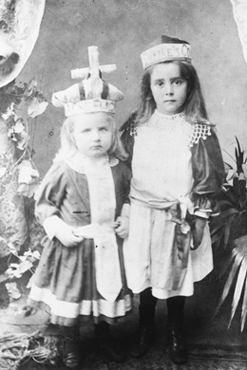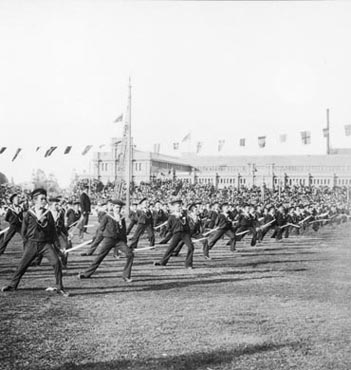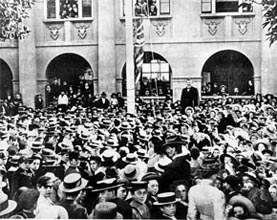Celebrations throughout the country
People flocked to Melbourne to witness the celebrations for the opening of Parliament.
More than 10 000 passengers were carried daily into Spencer Street station from country areas in the week before the arrival of the royal visitors, and special trains brought in official guests from other states. As a consequence some country areas were reputedly quiet during the week of festivities in Melbourne. Others held their own celebrations, such as picnics, flag-raisings and parades, to mark the opening.
The Duke and Duchess left Melbourne on 16 May and were greeted by enthusiastic crowds when they visited Brisbane, Sydney, Adelaide, Hobart and Perth.
 |

|
Festive Arch, Brisbane 1901
John Oxley Library, Brisbane
The royal couple visited Brisbane, 20–24 May. Aborigines stood in this festive arch in George Street. |
Welcome to Appleland Arch, Hobart, 1901
National Library of Australia
|
Children
No children participated in the grand formal ceremonies for the opening of Parliament, but Australian children were an important part of the celebrations.
Children were assembled and sang at vantage points of the great processions in Melbourne of 6 and 9 May. On 11 May, state school children participated in a fete attended by the royal visitors at the oval near the Exhibition Building.
 |

|
Enid Lyons (left) with her sister Nellie in fancy dress at celebrations marking the inauguration of the Commonwealth. Burnie, Tasmania, 1901
National Library of Australia |
Cutlass drill at the state schools fete, Melbourne
National Library of Australia |
On 13 May, at a ceremony in the Exhibition Building, the Duchess of York used a golden key to touch a button which flashed a telegraph message, ‘hoist the flag’, to stations through Australia. This pre-arranged signal was the cue for flag-raising ceremonies at public schools Australia-wide.
As Australia did not have its own separate flag or ensign, the flag of the British Empire, the Union Jack, was raised before some 650 000 school children, who took part in local ceremonies, competed in sports, picnicked, sang, cheered and saluted, and were presented with commemorative medallions.
 |

|
Raising the flag at Fort Street School, Sydney
Town and Country Journal, 25 May 1901
Image Library, State Library of New South Wales |
School children in Ballarat, Victoria, singing for the royal visitors
Town and Country Journal, 25 May 1901
Image Library, State Library of New South Wales |
|


